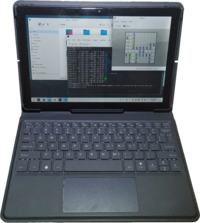PINE64 PineTab 2 (pine64-pinetab2)
 PineTab 2 with Arch Linux ARM | |
| Manufacturer | PINE64 |
|---|---|
| Name | PineTab 2 |
| Codename | pine64-pinetab2 |
| Released | 2023 |
| Type | tablet |
| Hardware | |
| Chipset | Rockchip RK3566 |
| CPU | ARM Cortex-A55 |
| GPU | Mali G-52 |
| Display | 800x1280 IPS LCD |
| Storage | 64 GB / 128 GB |
| Memory | 4 GB / 8 GB |
| Architecture | aarch64 |
| Software | |
Original software The software and version the device was shipped with. |
Arch Linux ARM 20230527 |
Extended version The most recent supported version from the manufacturer. |
Arch Linux ARM 20250104 |
| FOSS bootloader | yes |
| postmarketOS | |
| Category | testing |
Mainline Instead of a Linux kernel fork, it is possible to run (Close to) Mainline. |
yes |
pmOS kernel The kernel version that runs on the device's port. |
6.13.4 |
Unixbench score Unixbench Whetstone/Dhrystone score. See Unixbench. |
0.0 |
| Device package |
|
| Kernel package |
|
USB Networking After connecting the device with USB to your PC, you can connect to it via telnet (initramfs) or SSH (booted system). |
Untested
|
|---|---|
Battery Whether charging and battery level reporting work. |
Works
|
Screen Whether the display works; ideally with sleep mode and brightness control. |
Works
|
Touchscreen |
Works
|
Keyboard Whether the built-in physical keyboard works. |
Works
|
Touchpad Whether the built-in touchpad works. |
Works
|
| Multimedia | |
3D Acceleration |
Works
|
Audio Audio playback, microphone, headset and buttons. |
Works
|
Camera |
Untested
|
Camera Flash |
Works
|
| Connectivity | |
WiFi |
Partial
|
Bluetooth |
Untested
|
| Miscellaneous | |
FDE Full disk encryption and unlocking with unl0kr. |
Untested
|
USB OTG USB On-The-Go or USB-C Role switching. |
Works
|
HDMI/DP Video and audio output with HDMI or DisplayPort. |
Works
|
| Sensors | |
Accelerometer Handles automatic screen rotation in many interfaces. |
Works
|
Power Sensor Sensor to monitor current, voltage and power. Not fuel gauge! |
Works
|
Primary Bootloader Whether it is possible to replace stock bootloader with U-Boot. |
Works
|
|---|---|
Mainline Whether latest upstream versions of U-Boot are not broken and it is possible to use them. |
Works
|
Internal Storage Whether it is possible to boot from internal storage (e.g. eMMC or UFS). |
Works
|
SD card Whether it is possible to boot from SD card. |
Works
|
USB Host Whether it is possible to boot from a USB storage or connect a keyboard. |
Works
|
USB Peripheral Whether it is possible to use device as a peripheral in U-Boot, e.g. for fastboot mode. |
Untested
|
Display |
Works
|
Keyboard |
Untested
|
Buttons Whether it is possible to navigate in boot menu or grub with volume and power buttons. |
Works
|
| This device is based on the Rockchip RK3566. See the SoC page for common tips, guides and troubleshooting steps |
Contributors
- Danct12
Users owning this device
Installation
| WARNING: DO NOT FLASH POSTMARKETOS TO INTERNAL STORAGE! postmarketOS does not come with a bootloader. If you attempt to flash to internal storage, you'll brick it. |
Prerequisites
If you have the PineTab 2 before November 2024, you need to update the included U-Boot installation to at least version 2023.07.02-2 from the DanctNIX repos. After that, the device should boot from SD cards just fine.
Creating and flashing the image
Use pmbootstrap to build your own installation image.
$ pmbootstrap init
$ pmbootstrap install --fde
Now you can flash the image to an SD card using:
$ pmbootstrap install --sdcard=/dev/CARD
Hardware support
Wi-Fi
You can scan and try to connect to networks, but they seemingly all fail with an authentication error in dmesg regardless of whether they're secured or not.
One workaround is to either disable networkmanager or build with a user interface that does not install it (e.g. console or sway). You can either add `iw` in extra packages at build time or install it later using USB tethering. Then you can use the built-in `setup-interfaces` script to configure wlan0. DHCP does not run automatically in this configuration so you will need to either set a static IP during the setup or run `udhcpc -i wlan0` as root.
Debug Board (UART)
| Check your PineTab 2 box for the debug board if you don't have it yet. |
Pine64 ships a debug board with the tablet which has a switch to disable EMMC and SPI, forcing the device to boot from SD on low-level. It also includes an onboard USB-to-TTL (CH340) chip.
This adapter needs to be plugged to the bottom port (the charging port).
For UART functionality, connect the USB cable to the port with "DEBUG" silkscreen. The baudrate is 1500000.
See also
- pmaports!4208 Initial draft
- DanctNIX - The maker of the Arch Linux ARM fork for this device.